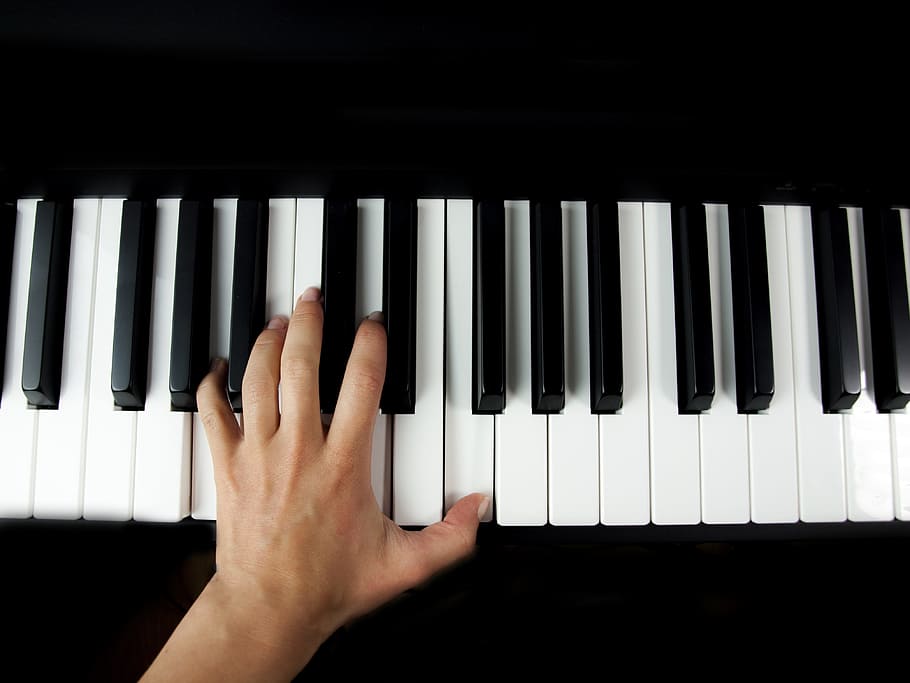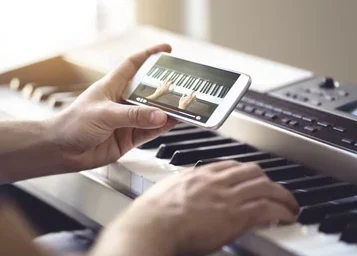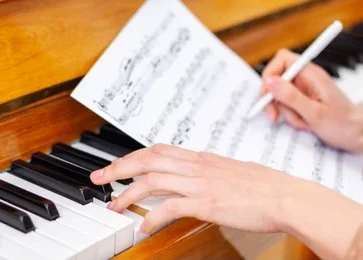
The piano is an exceptional musical instrument that soothes the ears of the listeners with its soothing chords and exceptional music. The idea of striking black and white keys that feels as soft as snow to strike some pleasant music amazes many people. And there are some who take some google classes to play the instrument completely in a span of a few weeks. The best way to master the instrument is to take it slow and learn it step by step in a progressing manner. This applies to beginners and amateurs who wish to pursue piano lessons as their passion or profession. Let us learn how to start playing piano chords as a beginner and progress to new lessons in the instrument.
How To Start A Career Out Of Producing Music?
- Many people have the desire to work as a music producer. New songs are written by music producers, which are then played on the radio, in bars, and in films and TV programmes all over the world. Although there are various ways to become a music producer, each one takes time and effort.
- Learn about music and take an interest in many musical genres from various eras. Think about what distinguishes one musical genre from another, what makes certain musical trends popular or obscure, etc. Learn to identify pitch, harmony, and pace while paying attention to how other musicians use their instruments and other sounds. You can either do this on your own or sign up for a music course to get you started.
- Regardless of whether a music producer doesn’t perform on an instrument professionally, it’s still vital for them to be able to read music and play instruments like the guitar, piano, and drums. A good technique to acquire musical ideas like chord progression is to learn how to play a couple of your favourite songs. Instead of waiting for a session musician, it can be beneficial to record your own sounds as you generate ideas during the creative process.
- Anyone with a computer can now more easily explore music production thanks to technology. A Digital Audio Workstation (DAW) can be downloaded by aspiring music producers so they can get a better understanding of the programmes used to record and create music. The software used in music production may initially seem difficult to use, but there are many online courses and tools to help you quickly and simply become familiar with its functions. When choosing a DAW, you have a variety of options, so take advantage of the free trial period to determine which one you like best.
- A professional-grade studio may be out of the price range of a beginning music producer, but it is still possible to start small and construct a studio as you advance. When you first start out, having a location just for making music can inspire you and encourage collaboration among artists. Start with the bare minimum of gear, such as a computer with a DAW, a soundboard, and mics in a quiet space, and make gradual investments to construct your studio.
- You may improve your networking skills with practice. It’s a crucial ability for music producers. Take advantage of opportunities to connect with people in the music business at performances, in studios, and online. Many emerging artists may be more eager to collaborate with you for no charge or in exchange for production services. By promoting your work online and at live events, you can draw potential collaborators and clients to you.
- Some music producers decide to pursue a degree in the field. These courses provide knowledge of the equipment needed to produce, mix, and master music. They can also provide an excellent chance to network with professionals in the field. Enrolling in an online course could be a cost-effective option to learn music production since many of them are free or less expensive than a college.
- You can make music no matter where you are in the process of becoming a music producer. Creating beats for other musicians, creating remixes of popular songs and noises, or even creating your own unique music are all examples of this. To establish your brand, bring in artists, and provide prospects for projects, think about the use of social media to advertise and share your work.
Best Apps To Learn Piano Online

- The beautiful thing about Perfect Piano is it allows you to use it in one of two ways: either using MIDI (musical instrument digital interface) keyboard, like the Yamaha P105, Roland F-120, or Xkey, or with the built-in virtual keyboard that requires you to tap on the screen of your phone. In either case, it provides an enjoyable and approachable way to learn countless famous tunes on the piano. The program gives you the option to select from a variety of guide patterns, including conventional sheet music, to play along with tunes. You can also lower the playback speed so that you can listen to songs at your preferred pace. The constructed virtual keyboard has all 88 keys found on a traditional grand piano and can produce a variety of sounds, including pipe organ, synthesizer, and grand piano. The app’s multiplayer option, which lets you challenge friends to determine who can perform songs the most fluidly, is another excellent innovation.
- Simply Piano offers lessons-based courses that are geared toward pianists of all skill levels, from absolute beginners to advanced players. Additionally, it enables you to study a wide range of songs & compositions, enabling you to put the principles you’ve learned into practice. In contrast to some other piano apps, it truly begins at the very beginning, guiding you through the fundamentals (such playing including both hands) and also offering customized, five-minute workouts that are catered to your level of proficiency. The app is free to install and then use, but in order to access all classes, you must upgrade to the premium version, which costs $150 for a full year.
- Skoove, which is available for iOS and Android, provides an extremely thorough and individualized piano-learning experience. It stands out from the competition since it makes use of artificial intelligence to understand what you’re playing and present you with the proper workouts for correcting any errors you may be making. You can choose the subject you want to study the most and advance your skills from there thanks to the more than 400 courses and over a thousand video tutorials that are included. It features a large library of music for you to learn, ranging from Beethoven and Mozart to the Beatles and Adele, similar to other piano instruction applications. It contains useful instructions and advice on note identification and aural music performance. The program features a virtual on-screen piano option in addition to being USB/MIDI and acoustic keyboard compatible.
- Piano Academy is yet another all-inclusive piano-learning program that has something to offer everyone, with an on-screen virtual keyboard and MIDI-keyboard compatibility. It offers a wide variety of tutorial films presented by an instructor who aids to demonstrate what you’re actually attempting to learn. Its lessons are divided into theory- or method-based sections. The fact that the app listens to you while you play and gives you feedback on how accurately you’re playing music is a lovely touch. It also has a variety of entertaining games for mastering the fundamentals of playing the piano, like hand coordination. Using an indication with sheet music that advances from note to note as you play, the app allows you to learn hundreds of songs. Overall, a really user-friendly and accessible app.
- Flowkey has about everything you might desire in a piano-learning app, including video instructions, quality interaction, and hundreds of tunes. It provides step-by-step tutorials and directions on numerous areas of technique, from reading music to chords and improvisation, and is aimed at players of all skill levels, from beginners to more experienced ones. Regardless of whether you’re performing on an acoustic or MIDI-connected piano, it also keeps track of your performance and offers tips on how to get better. The app is free to install and use, but in order to access the full library of educational resources, you must purchase a Premium account, which costs $20 once per month or $120 for a full year.
- Here is a piano-learning program designed exclusively for those without access to a keyboard or piano. With the help of the keyboard simulator app Piano, you can learn to play the piano on screen and get a taste of whether you’d like to make the investment and buy your own instrument. It features a variety of lessons on fundamental concepts, such as how to play specific chords, along with a variety of entertaining mini-games to make the entire process of learning a bit more enjoyable. Piano offers a unique way to learn several well-known songs, similar to other apps, with its Magic Tiles game, in which virtual tiles fall on the keyboard and indicate which keys to press when. In the end, it might not be quite as comprehensive as other applications, but it’s definitely entertaining. You may access weekly new tracks and more sounds for your virtual keyboard by purchasing the full edition of the app for $20 per month or $50 per year.
- Yousician may be more well-known among guitarists, but it offers the same level of depth as a piano-learning program. It features a large selection of well-known songs that you may play and practice along with, as well as over 10,000 exercises, lessons, and games to help you improve your piano skills. It covers pretty much everything, including helpful lessons and hints on music theory and how to interpret sheet music. The complete spectrum of content is only accessible to those who fork over a subscription fee of $10 a month or $120 per year, but it is free to access and use.
Choose The Right Piano As A Beginner
There is a lot to think about, and your options may seem complex, particularly if you are unfamiliar with all the terms. Don’t worry; once you start learning, everything will make sense. To decide, simply consider the following inquiries and refer to the table below:
- What do I anticipate in terms of dynamic range, sound, and feel?
- What is the size of my budget?
- Do I wish to play other sounds, such as strings, an electric piano, or an organ?
- How much room do I have?
- Should I play my instrument somewhere other than at home?
- What purpose is it going to serve? Professional or habitual.
Piano for Beginners – Mastering the Basic Terms
At the first look, I do admit that the piano sheet looks like some rocket science formulae paper. It is tough and at times overwhelming, but it is not that tough that you cant handle. To master these lessons, it is important to thorough certain basic piano terms.
Before getting in-depth to the piano chords, understand that the left hand generally plays the chords and the right-hand deals with the melody. The chords are generally a set of either two or three or more notes that are played concurrently. Such chords will get repeated through the song, and once you get the first few chords at your fingertip, then you can master the entire song easily.
The piano chords are essentially the combination of piano notes, which are the sounds you get by hitting the individual keys on the instrument. Each of the keys emits different sounds and the pattern of these keys repeats through the length of the instrument. These notes either start from A- G or from C-G, with A and B at the end (C-D-E-F-G-A-B).
Check out: Top 10 Piano Tips and Tricks for Beginners
Fingering to Play Piano Chords

Before getting into the details of chords and notes, you should have noticed that the instrument is played with two hands, just like a typewriter. You should be aware of the keys for your left hand and right hand separately. For the left hand and the right hand, the count starts from the thumb finger as follows –
1- Thumb Finger
2- Index Finger
3- Middle Finger
4- Ring Finger
5- Little Finger
For chord fingering, you will mostly be using 5-3-1 from your left hand and 1-3-5 from your right hand.
What Are the Major Chords and Minor Chords?
Major chords are simple to master and the reason why we recommend these for you to learn first is that these chords are strong, bright and upbeat. You gain tremendous confidence when you start your lessons by mastering these chords. Also, major chords make up the entire fast beat song that are in your list to learn.
There are 12 major chords that one can play on the piano, with a number of variations. There are hundreds of probabilities to play with these chords and the only good news here is that you don’t have to memorize all of them. There are certain formulas, that you can remember, so as to learn piano pretty fast, with taking them by heart.
The minor chords occupy your sad and sentimental songs and comprise of dark and moody sounding chords. There are 12 minor chords with many variations and you can remember them with the help of formulas again.
Apart from major and minor chords, there are also diminished chords, suspended chords, all 5ths, all 7ths, etc.
Chord Progressions
Chord progressions are the different chords in succession that you have to master, in order to play a song. The chord progressions are the combinations that make up the song and you will have to know what chord to play, in what order so as to complete playing a song perfectly. The best way to start is to play the chord progressions of famous and known songs, before trying to learn new ones.
Some Basic Piano Chords
Beginners have to learn and master the basic piano chords before progressing to much-advanced levels and attempting the different types of piano chords such as diminished, augmented, etc. In order to learn the basic piano chords, you should do skip counting as 1,3,5 and use your index, middle and little fingers to play these three alternating notes.
To master these alternating strokes, it is important to ascertain the difference between a half step and a full step. A half step is achieved when you jump from one note to the one above it directly. Jumping from C to C# (the black key) is a half step. A full step is achieved when you jump from between successive keys, which is from C to D. Thus, in order to get a major chord, you will have to choose a note, such as C major and then go C#, followed by D, D# and then E. complete the chord by progressing to E, E# (which is F), F# and then G, which will be completed by your little finger. ***(The half step after E is actually F, the white key, which is denoted as E#. The next full step will be F# which is actually a black key)
Thus in order to complete a full major chord, you will have to do two full steps and one 1.5 steps, starting from C to G. If you wish to play the minor chord, it is just the opposite. You will have to start with 1.5 steps and then progress to 2 complete steps.
Related Reading: How to Sit Properly at The Piano: Correct Your Posture
Wrapping Up
What we have explained here is the simplest of all piano lessons, reserved for beginners, there are of course more advanced chords that you can master with practice. Once you master the augmented chords, suspended chord, and diminished chords, you can consider yourself a master of this musical instrument. It is your skills and your imaginative power to manipulate the instrument into playing different types of music. Learn the basics from the books and master the piano with your own hands.
Related:-
Frequently Asked Questions (FAQs)
1. What are the skills a music producer must have?
Multiple instrument proficiency: Playing an instrument can deepen your comprehension of musical ideas and assist you in producing your own music samples.
Melody, rhythm, and pitch: For producers and musicians, knowing which sounds are in certain keys is an essential ability.
2. How much do music producers make on an average?
In the US, the base wage for a music producer is on average $42,336 annually. The salary for a music producer might vary depending on their level of renown, the projects they work on, the musicians they collaborate with, and whether they function independently or for a company.
3. What is a metronome?
In order to keep you in time with the tempo (pace) that you choose, a metronome produces an audible sound (often a click or a beep). Although you don’t definitely need one, it can be beneficial in the beginning if you see that your pace is varying.
4. What is dynamic range?
You have access to this volume range when you touch the keys. You are forced to either pound the keys or hardly hear the notes due to low dynamic range.
5. Why is dynamic range important?
The seamless transition between loud, quiet, and any other volume is made possible by a high dynamic range. You may play with genuine passion and emotion if you have good control over your dynamic range. The top musicians can even change dynamics while playing many notes at once because they have such excellent control over their dynamic range.
